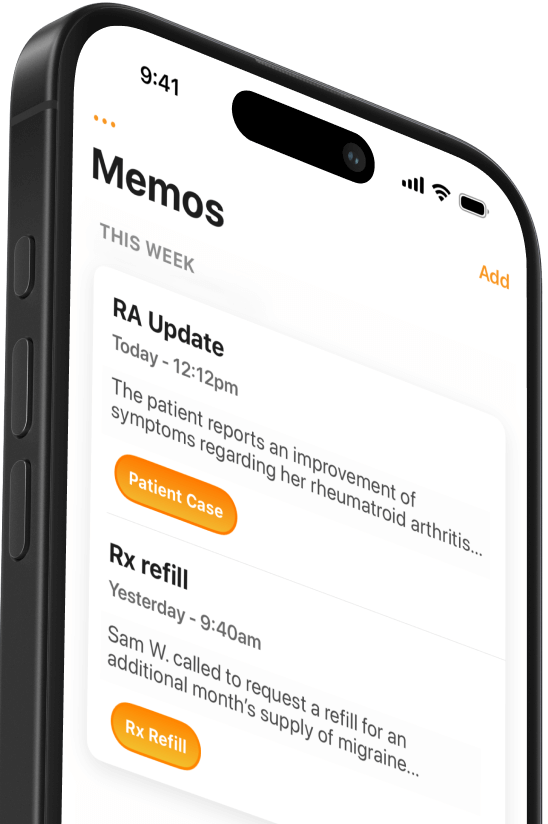Manage your EHR inbox more effectively with these tips
PCPs spend 13+ hours a week on inboxes. Use 14 strategies to delegate, automate, and manage EHR messages more efficiently.


Popular articles
Manage Your EHR Inbox More Effectively with These Tips
Many physicians are drowning in administrative tasks, and the EHR inbox is a major culprit. While we often focus our blog articles on streamlining clinical documentation, managing the deluge of messages in your EHR is equally important.
A recent study found that primary care physicians in a Massachusetts hospital spent an average of 36 minutes per visit using the EHR, with nearly 8 minutes dedicated to the EHR inbox. For the average PCP seeing 20 patients per day, that adds up to over 13 hours per week.
How to Take Control of Your EHR Inbox
Whether your goal is to reclaim time or improve patient communication, these 14 tips–inspired by Jay Winner, MD–will help.
1. Coordinate Inbox Work with Your Team
Many EHR systems default to all messages going to the physician. Ask IT staff to help configure your inbox to route messages to other staff, like nurses, medical assistants, and even front desk staff. The goal of delegating is for everyone on your team to work at the top of their license.
2. Train Staff to Fill Out Forms
If you’re manually entering patient details on forms, you’re wasting valuable time. Train your team to complete as much as possible before passing it to you for approval. Not only does this lighten your workload, but it also provides valuable training for your staff.
3. Establish Protocols for Urgent EHR Messages
Which messages are urgent, and which can wait? You’ll feel less stressed about your EHR inbox if you create a clear triage system so staff knows which messages need immediate attention. Forwarding urgent messages to a triage nurse can help determine whether a patient needs an appointment, urgent care, or an ER visit.
4. Use Message Templates
Don’t type the same response over and over. Standardized message templates can speed up replies to common inquiries, like prescription refills and test results. Many EHRs allow you to create and customize these templates, so check what’s already available in your software. Using templates will make your communication more consistent and efficient.
5. Use AI and Smart Automation Tools
If you’re open to exploring new technology, consider AI tools. More EHRs are integrating smart automation tools to process routine messages, suggest responses, or even draft replies based on past communications. This approach is kind of like using EHR message templates but on steroids. Once you get the hang of it, AI-powered inbox features can cut your typing time significantly.
6. Review Your Inbox Before Staff Leave
You might not be ready to embrace hi-tech AI tools, but everyone can benefit from this low-tech habit. If you often work late, set aside 30 minutes before your staff leaves for a quick inbox review. Forwarding tasks they can handle before they log off will lighten your after-hours workload. This routine will also help you complete more tasks before signing off for the day, which makes it easier to switch gears and wind down after work.
7. Discuss Test Results in Visits When Possible
Pre-visit lab testing can help eliminate unnecessary follow-ups. If patients get labs done before their visit, you can discuss results in person rather than playing inbox tag.
8. Streamline Prescription Refills
Medication refills can be a serious time drain. Write prescriptions to last until the next visit when appropriate, and work with your team to create a refill protocol that allows staff to process requests for your review.
9. Minimize Repetitive Tasks
Notice which keystrokes and EHR inbox tasks you repeat many times throughout the day. How might you automate or eliminate these repetitive actions? For example, badge readers can replace manual logins, and some EHRs offer one-click messages like “Needs labs.” Minor optimizations like these save hours over time.
10. Eliminate Unnecessary Messages
Some messages just never need to be sent, like an automatic notification for lab results that you already ordered. Work with IT to adjust your EHR inbox notification settings to unsubscribe from non-essential alerts.
11. Batch Process EHR Inbox Messages
Constantly checking the inbox can feel distracting and be inefficient. For this reason, many physicians find it helpful to schedule dedicated time blocks–say 30 minutes three times per day–for reviewing and responding to messages. Consider working with your team to build this structure into clinic scheduling.
12. Implement a “One-Touch” Rule
Similar to batch processing, some physicians adopt a "one-touch" approach to the EHR inbox. It’s simple: whenever you open a message, commit to respond, forward, or resolve it immediately rather than setting it aside to revisit later. Building this habit will save you time by never rereading the same message multiple times.
13. Educate Patients on Self-Service Options
Often, patients send a message because they don’t know how to use self-service options to find information or complete a task. At each visit, have someone on your staff remind patients that they can use the portal to schedule appointments, request medication refills, and access lab results. You can even post educational posters or run an explainer video in the waiting room. The more patients use these tools, the fewer messages flood your inbox.
14. Use Team Huddles to Address Common Questions
If multiple inbox messages involve the same issue (e.g., a new protocol change), a quick morning huddle with your team can proactively address common concerns and reduce repetitive messages throughout the day.
Keep the Bigger Picture in Mind
EHR inbox efficiency is crucial, but incremental changes may not be enough if your workload is unsustainable. If you apply these tips and are still overwhelmed, ask yourself:
- Is your patient schedule too full?
- Does your clinic have adequate staffing?
- Are you maximizing coding for productivity-based pay?
If individual optimizations aren’t enough, advocate for broader changes within your organization. Start with what you can control, but remember that some issues require team or organizational changes to make your job more manageable.
Related Articles


We Get Doctors Home on Time.
Contact us
We proudly offer enterprise-ready solutions for large clinical practices and hospitals.
Whether you’re looking for a universal dictation platform or want to improve the documentation efficiency of your workforce, we’re here to help.





